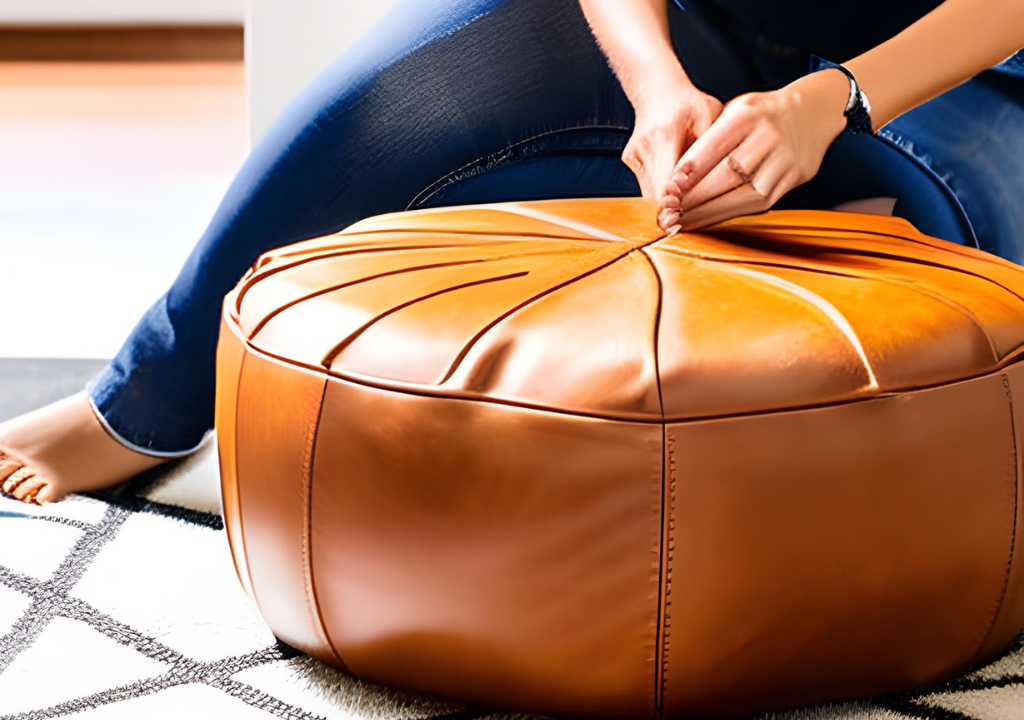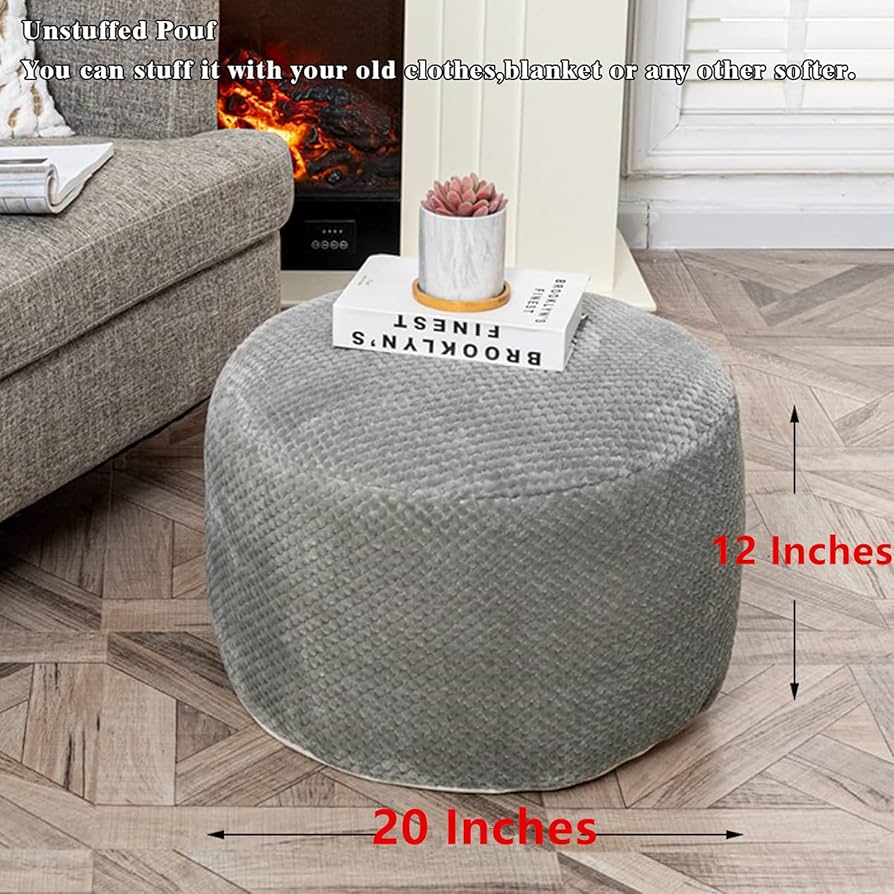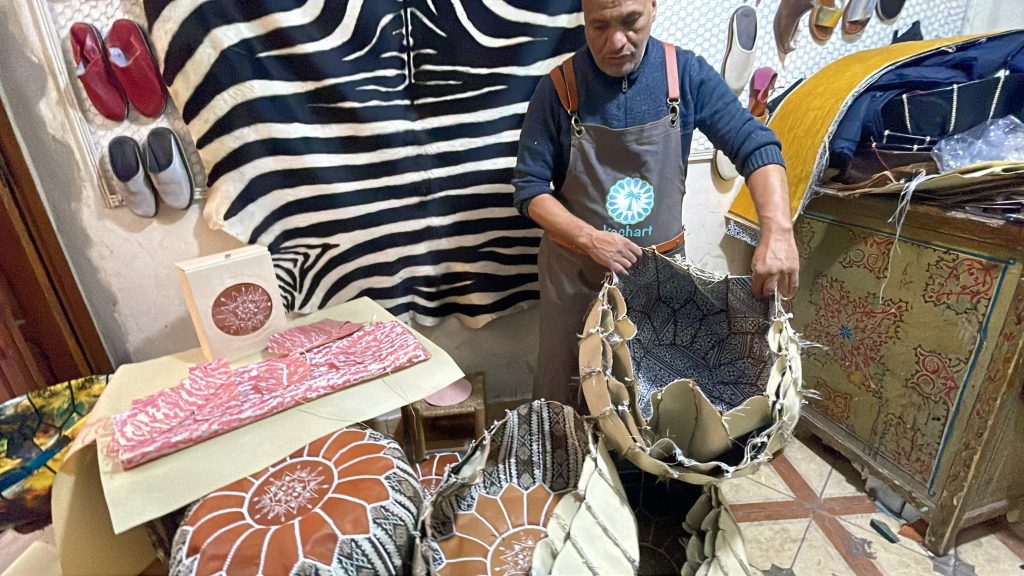Are you wondering what’s the best thing to stuff a pouf with? Choosing the right filling can make all the difference in comfort, durability, and style.
Whether you want a pouf that’s soft and squishy or firm and supportive, the stuffing you pick will shape your experience. You’ll discover the top options for pouf filling, how each one feels, and which suits your needs best. Keep reading to find out how to make your pouf perfect for your space and lifestyle.
Types Of Pouf Fillings
Choosing the right filling for your pouf affects its comfort and durability. Different materials offer different levels of softness and support. Some fillings are light and flexible, while others provide firm structure. Understanding these options helps you pick the best fit for your needs.
Foam Beads
Foam beads are small, lightweight balls that fill the pouf evenly. They allow the pouf to mold to your body shape. This filling is soft and offers good support. It is also breathable, making the pouf cool to sit on. Foam beads are popular for bean bag style poufs.
Polyester Fiberfill
Polyester fiberfill is a fluffy, soft material similar to pillow stuffing. It makes the pouf plush and comfortable. This filling is affordable and easy to work with. It provides a light, cushy feel but may flatten over time. Polyester fiberfill works well for decorative poufs.
Memory Foam
Memory foam molds to the body and returns to its shape slowly. It offers excellent support and comfort. This filling is dense and heavier than others. Memory foam poufs feel firm but soft at the same time. They are great for people needing extra support.
Natural Fillings
Natural fillings include materials like cotton, wool, or dried beans. These offer an eco-friendly option for poufs. Natural fillings provide moderate firmness and comfort. They may be heavier and less flexible than synthetic options. This choice suits those who prefer organic materials.
Recycled Materials
Recycled fillings use leftover foam, fabric scraps, or plastic beads. They help reduce waste and support sustainability. These materials vary in softness and durability. Recycled fillings can match the comfort of new materials. This option appeals to eco-conscious buyers.

Credit: yarnandchai.com
Comfort And Support Factors
Choosing the right stuffing for a pouf affects its comfort and support. The filling must balance softness with durability. Comfort depends on how the pouf feels during use. Support relates to how well it holds shape and weight. These factors guide the best material choice for stuffing.
Firmness Levels
Firmness influences sitting comfort and posture support. Soft stuffing offers a cushy feel but may lack support. Firmer fillings provide stability and resist flattening. The best stuffing matches your preferred firmness level. Consider how long you plan to use the pouf each time.
Flexibility And Shape Retention
Good stuffing keeps the pouf’s shape over time. Flexible materials adjust to body curves while bouncing back quickly. Some fillings compress easily and lose shape fast. Choose stuffing that balances flexibility with durability. This ensures the pouf stays comfortable and looks good.
Weight And Portability
Lightweight stuffing makes the pouf easy to move. Heavier fillings offer more stability but reduce portability. Think about where you will use the pouf most. A portable pouf suits spaces that change often. A heavier pouf works well as a fixed seat or footrest.
Durability And Maintenance
Choosing the right filling for your pouf impacts more than just comfort—it also affects how long it lasts and how easy it is to keep clean. Durability and maintenance should be top priorities if you want your pouf to stay fresh and functional over time. What you stuff inside can make all the difference in daily use and upkeep.
Longevity Of Different Fillings
Some fillings hold their shape better than others. For example, high-density foam offers excellent support and tends to last longer without flattening. On the other hand, polyester fiberfill is soft but can compress quickly, requiring frequent fluffing.
Natural materials like buckwheat hulls are durable and mold to your body, but they may shift inside the pouf, causing uneven wear. If you want something low-maintenance, consider recycled foam beads—they combine durability with flexibility and resist breaking down over time.
Ease Of Cleaning
Think about how easy it will be to clean your pouf filling. Foam and fiberfill can trap dust and odors, making them harder to freshen up without removing the cover. Materials like microbeads or buckwheat hulls are less likely to hold onto allergens and can often be spot-cleaned.
If you have pets or kids, you might want fillings that dry quickly and don’t absorb spills easily. A pouf with removable covers combined with fillings that tolerate a quick wipe or air-out saves you time and hassle.
Allergy Considerations
Some fillings can trigger allergies or attract dust mites. Polyester fiberfill and foam sometimes trap allergens, making them less ideal if you suffer from sensitivities. Natural fillings like buckwheat hulls are hypoallergenic but may not suit everyone due to their texture and sound.
Have you thought about how your pouf filling could impact your air quality? Choosing hypoallergenic materials or fillings you can easily wash or replace helps keep your living space healthy. It’s a simple step that can improve your comfort significantly.
Cost And Availability
Choosing the right filling for a pouf depends on cost and availability. These two factors affect your budget and project timeline. Some materials are cheap but hard to find. Others are expensive but easy to buy. Knowing the price and where to get these fillings helps you make the best choice.
Price Comparison
| Filling Material | Average Price (per pound) | Durability |
|---|---|---|
| Polystyrene Beads | $2 – $4 | Medium |
| Foam | $5 – $10 | High |
| Recycled Fabric | $1 – $3 | Low to Medium |
| Natural Fillings (e.g., Cotton, Wool) | $4 – $8 | High |
Polystyrene beads cost less and suit casual use. Foam lasts longer but costs more. Recycled fabric is very cheap but may break down fast. Natural fillings offer comfort but vary in price.
Where To Buy Fillings
- Craft stores often carry foam and beads.
- Online shops offer wide filling choices.
- Fabric stores sell recycled and natural fibers.
- Local recycling centers may provide low-cost fabric scraps.
- Some upholstery shops have leftover foam pieces.
Buying locally saves shipping costs and time. Online stores have better variety but add delivery fees. Check quality and reviews before purchase.
Filling Recommendations For Different Uses
Choosing the right filling for a pouf depends on its use and comfort needs. Lightweight beads offer softness, while foam provides firm support. For extra durability, shredded memory foam works well.
When selecting the perfect filling for your pouf, it’s essential to consider the specific use case. Different environments and purposes call for unique stuffing materials to ensure comfort, durability, and style. Let’s explore some recommendations for various pouf applications.Living Room Poufs
For living room poufs, comfort and style are paramount. You want something that looks chic but also invites guests to sit or rest their feet. Memory foam is an excellent choice because it molds to the body and returns to its original shape, maintaining the pouf’s structure. If you prefer a more traditional feel, consider using polyester fiberfill. It’s soft, maintains shape well, and is budget-friendly. Have you thought about using old clothes or fabric scraps? They offer a sustainable option and a unique touch to your living space.Outdoor Poufs
Outdoor poufs face the elements, so durability is key. Water-resistant beads or polystyrene beads are lightweight and resistant to moisture, making them ideal for outdoor use. They dry quickly and prevent mold growth, ensuring longevity. You might also consider using recycled plastic bottles. They’re environmentally friendly and surprisingly comfortable. Have you ever experienced the convenience of a pouf that’s easy to move around the patio? This filling makes that possible.Kids’ Poufs
Kids’ poufs need to be safe, soft, and durable. Bean bag filling is a popular choice as it provides a plush feel that kids love to sink into. It’s lightweight, allowing children to move their poufs around easily. Another fantastic option is cotton batting. It’s natural, hypoallergenic, and can withstand rough play. Are you concerned about spills and stains? Consider using a washable cover for added protection and ease of cleaning. Choosing the right filling can transform how your pouf looks and functions. What’s your pouf stuffing strategy?
Credit: medium.com
Diy Pouf Filling Tips
Choosing the right filling for a pouf can change its comfort and look. DIY pouf filling lets you customize softness and firmness. Experimenting with different materials can create a unique feel and style. Here are helpful tips to fill your pouf effectively.
Combining Materials
Mixing different fillings improves comfort and durability. Use lightweight foam for softness and polyester fiber for support. Adding small foam pieces with beads or pellets gives a squishy texture. Combining materials balances firmness and flexibility. Try blending old fabric scraps with stuffing for an eco-friendly option. Layer different fillings for a tailored feel.
Refilling And Adjusting
Poufs lose shape over time and need refilling. Check the pouf regularly for lumps or flat spots. Add more stuffing to restore volume and comfort. Remove some filling if the pouf feels too firm. Adjust gradually to reach the perfect balance. Always zip or sew the pouf cover tightly after refilling. This keeps the filling secure and neat.

Credit: www.amazon.com
Frequently Asked Questions
What Materials Are Best For Stuffing A Pouf?
The best pouf stuffing materials include foam beads, polyester fiberfill, and shredded memory foam. These provide comfort, durability, and shape retention. Choose based on firmness preference and intended use.
Can I Use Recycled Materials To Stuff A Pouf?
Yes, recycled fabrics, old clothes, and foam pieces work well for pouf stuffing. They are eco-friendly and cost-effective while offering good support and softness.
How Does Foam Bead Stuffing Affect Pouf Comfort?
Foam beads offer lightweight, moldable support that adapts to body shape. This makes the pouf comfortable and easy to move around the room.
Is Polyester Fiberfill Suitable For Outdoor Poufs?
Polyester fiberfill is resistant to moisture and mildew, making it a good option for outdoor poufs. It remains soft and durable in various weather conditions.
Conclusion
Choosing the right stuffing makes your pouf comfy and durable. Foam gives soft support, while beads offer flexibility. Old clothes or fabric scraps work well for a budget option. Consider how you will use the pouf daily. Easy-to-clean stuffing helps keep it fresh longer.
Think about your comfort and style preferences too. A well-stuffed pouf can brighten any room and relax your body. Experiment with different fillings to find your favorite feel. This small choice makes a big difference in your space.





